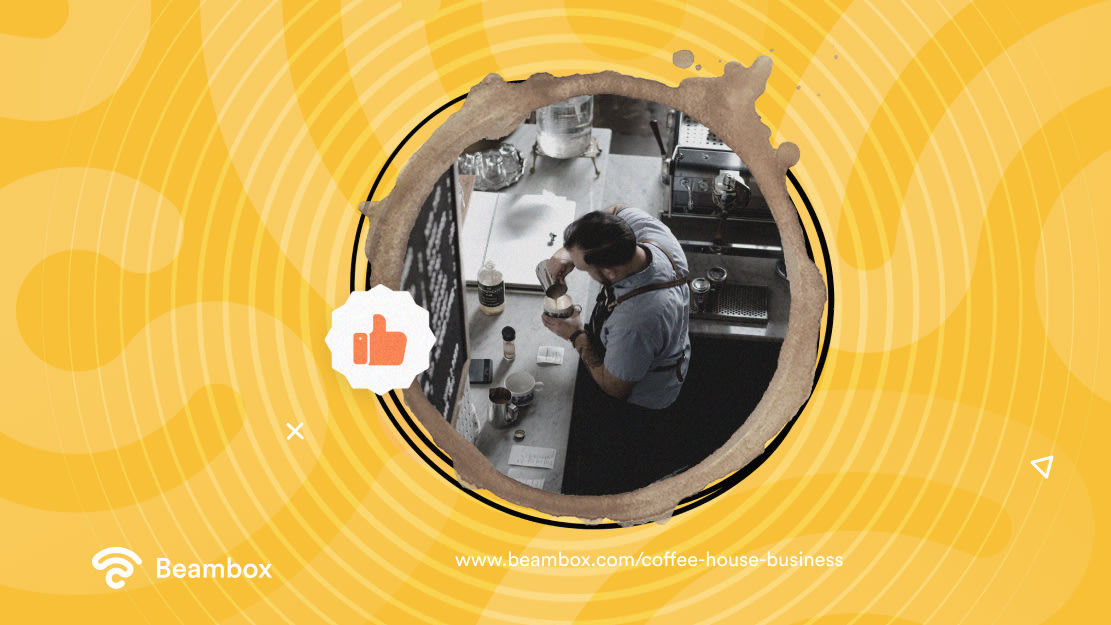A coffee house business has excellent potential to become a profitable venture. You can make a good name here even if you don’t see yourself competing with big names like Starbucks. That’s because people prefer to visit local coffee shops, especially with the concept of sustainable coffee.
However, that won’t be possible without following the right steps. This is more difficult if you’re new to the business landscape.
But don’t worry—this article has everything you need in one place. It will teach you the seven steps to opening a successful coffee shop and give you three tips for growth. So, let’s start the exploration.

How Much Does It Cost To Start a Coffee House?
Starting a coffee shop requires you to invest somewhere between $20,000 to $400,000.
As you can see, there’s a large gap between the minimum and maximum amount here. That’s because your specific investment will depend on the location, type of coffee shop, equipment, ingredients, and taxes. Hidden costs can also arise, such as licenses, employee training, interior design, etc.
But how much does it cost to start a coffee house of a specific type?
- Coffee food truck: $50,000 to $175,000
- With seating and drive-through: $80,000 to $400,000
- Coffee stand: $60,000 to $125,000
- Adding a coffee menu when opening a bakery or cafe: $25,000 to $80,000
Starting a Coffee House in 7 Simple Steps
Did you know that 66% of Americans drink coffee daily? Some like theirs dark and original, while others treat it as a sweet indulgence. But regardless of preference, coffee has become a part of morning routines.
Not all of them have an espresso machine at home, so they head over to coffee shops. If you know this, you might be thinking of starting a coffee house. For that, here are the seven steps you need to follow.

1. Research the Market, Audience, and Coffee House Business Ideas
The first step is to conduct thorough research about the market, coffee house business ideas, competitors, and target audience. This might be difficult for people who aren’t close to the business landscape. To make it easy, let’s discuss each research area separately.
Starting with market research helps you see whether starting a coffee shop would be worthwhile. After all, there’s no use in starting a coffee shop if nobody is demanding coffee in your area. Therefore, research the market and ensure the demand exceeds the supply.
Next, research the coffee shop marketing ideas that bring in the most money. In addition to the types of coffee shops we mentioned above, you can pursue various themes. Some examples include a coffee house within a bookshop, an independent coffee shop, remote workplaces, or art exhibitions.
Again, explore the market to choose the one that fits your idea of a coffee shop business. You can also visit your competitors to see what type of coffee shops they’re running.
That brings us to the next research area: competitor analysis. Before starting any business, you should settle on a unique selling point. What can you offer your customers that others can’t? This will help set you apart and gain more customers quickly.
But for that, you have to know your customers. Therefore, research your coffee shop’s target market and see what type of coffee drinkers you want to serve.
There are various types of target markets, and each category requires a different kind of treatment. So, no matter how unique your offering is, it will fail if it doesn’t resonate with potential customers.
2. Create Coffee House Business Plans
Do you know how restaurant chefs create recipes, source ingredients, and practice techniques before creating a new dish? Coffee house business plans are like those recipes, except here, the goal is a successful coffee shop instead of dishes. These are comprehensive documents outlining the details of starting and running a coffee shop.
So, once you’ve conducted the research, work on creating a coffee shop business plan. All you need to do is ask yourself a few questions. Why do you want to start a coffee shop business, how much do you want to earn, etc? Once you have the answers, combine them with your research.
However, the written part of the plan starts with an executive summary. It’s an overview of everything the reader will get in the document.
Next, write the description of your coffee shop. This section is worthwhile as it includes your offerings, organizational hierarchy, vision, mission, and unique selling point.
Follow the business description with an analysis of the market and coffee industry. Write down your strengths, weaknesses, areas of improvement, and competition.
Then, add your investment plan, costs, and financial analysis. Moreover, you must add your profit and loss statements and financial projections to the business plan. Remember, investors and partners will pay the most attention to these sections, so consider them. Lastly, write down the marketing plan for your coffee shop.

3. Secure Funds To Launch the Business
Launching any business requires some investment. The same is true for a coffee shop, where you’ll have to buy land, equipment, hire staff, etc. For that, you’ll need startup capital.
Now, there are various options to secure funds. The first and most obvious option is to save money yourself. But this might take time since starting a business from scratch is quite expensive.
If you don’t want to wait, consider bank loans and investors. Again, you have multiple options to secure these business loans. Your municipality, country, or city might provide you with small business loans, but you’ll have to do some research.
Another option is to obtain state- or federal-level grants or consult with private foundations. To make your choice, head over to USBusinessGrants.org.
4. Find a Suitable Location for Your Coffee House Business
The next step is to find a suitable commercial space for your coffee house business. Many coffee shop owners think they have the perfect location, but they only find out it doesn’t fit their needs. Don’t let this happen to you by assessing your needs because starting the location hunt.
For example, a cafe with only a drive-through will require less space than one with a drive-through and seating. Similarly, you’ll need extra space to add outdoor seating.
Apart from that, you must choose a profitable location. People in that area must demand the type of coffee you sell to have consistent foot traffic. You also need to ensure you don’t have a lot of competitors in the area.
The best way to approach this step is to create a list of locations that interest you. Then, observe these locations and find a profitable one.
However, cost is another factor that you need to consider. If you don’t want to make huge investments right now, renting the space might be your best shot.

5. Work on the Menu and Pricing
When it comes to coffee shops, a successful business usually starts with a thoughtful menu. You can’t just throw in all types of coffee and call it a day. Your menu must match your brand values and culture for it to make sense to customers.
For example, if you’re promoting sustainability, you can’t have a large menu with a high volume of food waste.
It’s a good idea to keep multiple options that appeal to different kinds of customers. However, an overly complicated menu will only confuse customers.
So, strike a balance between variety and simplicity. Start with a few items in each category, slowly testing and adding more options.
Apart from the dishes, you must also decide on the pricing of each menu item. Again, observing your competitors would be a good idea.
See how they’ve priced their beverages and what would be the most profitable for you. Customers usually don’t mind paying more if the coffee shop’s focus is on quality.
6. Buy Coffee House Supplies and Equipment
After research, planning, financing, location hunting, and menu engineering, shift your focus to coffee house supplies and equipment.
You’re on the right track if you’re thinking of coffee beans, espresso machines, coffee grinders, and milk frothers. However, the list of coffee shop equipment has only started. You also need water filtration systems, furniture, refrigerators, blenders, coffee roasters, food preparation equipment, dishwashers, menu boards, and display cases.
Besides, how will you serve cups of coffee without mugs and disposable containers? So, also order those and any other containers you might need to serve the food and beverages.
Technology is also a part of supplies when it comes to running a coffee shop. You need POS systems to take orders and keep track of them. That’s the most basic technology you’ll need. But if you’re thinking about going all out, add inventory, customer, and employee management systems to the mix.
Additionally, acquire the necessary licenses and permits to run your coffee shop. Each state and country has its own rules for researching and seeing what the authorities in your location require. Since you’re dealing with food, you’ll probably need health permits. Then, there are business licenses, work permits, location permits, etc., that you need to focus on.

7. Design the Layout and Hire Staff
Now that you’ve ordered the equipment, it’s time to think about where you’ll place each thing. In simpler terms, the next step is to design the coffee shop’s layout. For this, you can hire an interior designer or create something independently. With the amount of inspiration available online, you’ll probably be good on your own.
Consider where you want the kitchen, ordering counters, and seating arrangements. Make sure your customers aren’t too close to your kitchen. Otherwise, the sound and smell might disturb them.
Also, if you’ve decided to incorporate a theme, create a plan for it. For example, consider where you’ll place the bookshelves and reading corners if you want a bookish coffee shop.
However, running a coffee shop isn’t a feat for a single person. You also need baristas, coffee artists, chefs, servers, managers, and cashiers. There’s no need to go overboard and create a large team. Only the most basic staff would do. You can always add more roles as you scale your business.
How To Launch a Coffee Shop Business
Planning to start a coffee shop is one thing. But actually launching it is a whole other task. How will you get the word out to customers and ensure they visit to buy something? That’s where launch day planning comes in.
You don’t have to host a grand launching party because the right marketing strategy will do the job. But you must get creative and create campaigns that nobody can resist.
Start building a story from day one and ensure people resonate with it. For example, a coffee shop with ethically roasted beans can use hand-painted mugs with origin stories of the beans.
Add a few discounts for launch day with coffee shop hashtags, and you’re good to go. Post this campaign to all your social media accounts. Moreover, you can create and distribute pamphlets in nearby areas.
You can even partner with an already-established bakery to expand your reach. Tactics like these will ensure a good first impression.
[PICTURE: https://www.pexels.com/photo/a-coffee-shop-with-equipment-at-the-bar-13772699/ - ALT: The interior of a coffee shop showing the counter, equipment, supplies, and cups.]
3 Tips for Growing Your Coffee Bar Business
Now that you know how to start and launch a coffee shop, let’s move on to growth techniques. Correctly following all the steps will set you up for success. But remember, marketing is a huge part of growth, but there’s more to it than meets the eye.
In the coffee industry, customer demands and market trends constantly change. To grow in these changing circumstances, preparation is key. Here are three tips for growing your coffee bar business.
1. Always Focus on Quality and Service
You’ve probably already heard and read about focusing on quality and service. But this tip is worth repeating a million times because these two things must be your topmost priority. Customers can forgive an uninteresting interior and even higher prices if they get quality and good customer service.
Therefore, make sure the taste of your coffee stays the same. Never compromise on the cleanliness of your mugs, furniture, and overall interior.
Delaying a customer’s order leads to frustration. Use staff scheduling software to assign tables and serve your customers quickly.
If a customer becomes angry, avoid getting angry in return. Solve the problem quickly and with composure. Such actions will help you gain customer loyalty, and your business will grow quickly.

2. Launch a Loyalty and Referral Program
It’s a thing of the past when only a few businesses had loyalty and referral programs. They’re the best way to gain regular customers who eventually become brand ambassadors.
Now, you have a few options for approaching this tip. The first idea is to create a point system where customers get specific points on each visit. Once they’ve accumulated a set number, they can redeem their rewards.
Secondly, you can create tiered programs to create different levels. The higher a customer is, the more regards they can enjoy. You can also reward a customer when they bring you a new customer through a referral program.
As you can see, how you want to reward your customers is your call. But no matter what you decide, loyal customers will be the precise result.

Earlier, we mentioned that marketing is a massive part of a coffee shop’s growth. But that won’t happen unless you get creative with your promotions.
For that, keep your customers engaged by constantly developing new campaigns. Make their experience enjoyable by incorporating guerilla marketing. It’s not only inexpensive but also the most interesting marketing tactic. You can go as subtle as printing your logo on mugs to as bold as huge coffee cups on streets.
Moreover, coffee shops have become a place to socialize, where people form new friendships and connections. They spend hours just catching up with friends or creating business plans.
Take advantage of this and offer free coffee shop WiFi in your venue. Not only will you get more customers, but you’ll be able to keep them in your coffee shop for longer. The longer they stay, the more chances you have of making another sale.
However, ignoring a captive portal would be a grave mistake here. These web pages help you authenticate customers and create customer databases. You can even promote brand awareness and promotional campaigns on this page.
So, invest in good WiFi marketing software and implement captive portal WiFi on your guest network.
Each time customers try to connect to your WiFi, they’ll need to provide details like names and email addresses. Later, you can use this data to personalize your marketing efforts. That’s another growth tactic in itself.
Running a Coffee Shop Business Requires the Right Game Plan
Running a coffee shop business isn’t easy, especially without a plan. But if you follow the steps above, you’ll be on track to start a successful coffee house business. You must research the market, create a business plan, and secure funding. Next, create your menu and pricing, buy equipment, design the layout, and hire well.
Loyalty and referral programs are your best friends. Moreover, creative promotions like guest WiFi marketing are game changers. Using Beambox’s WiFi marketing solution, you can gather customer data and automate your marketing campaigns. Are you ready to go? Try Beambox for free for thirty days!
Get Started With Free WiFi Marketing
Beambox helps businesses like yours grow with data capture, marketing automation and reputation management.
Sign up for 30 days free